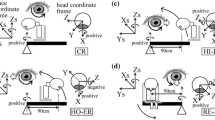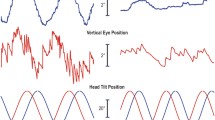Abstract
We recorded three-dimensional eye movements during angular acceleration steps from 0 to 250°/s at 20°/s2 about an earth-vertical axis. Experiments were performed on 27 normal subjects and on 19 patients who had recovered well from unilateral vestibular deafferentation on the right or left side. In addition to compensatory horizontal eye movements, significant vertical and torsional eye movement components were elicited. These vertical and torsional eye velocity traces led to a shift of the axis of eye velocity away from the axis of head velocity. Horizontal, vertical, and torsional velocity components showed clear differences between normals and patients with unilateral vestibular deafferentation. In normals, the axis of eye velocity tilted backward and slightly away from the axis of head velocity. Patients showed similar, but more pronounced, shifts during rotations toward the intact ear and shifts in the opposite direction for rotations toward the operated ear. Eye velocity traces were analyzed with special consideration given to the orientation of the axis of eye velocity. We speculate that the vertical and torsional velocity components may be due to the effects of Listing's plane, as well as the contributions of the otolith signals.
Similar content being viewed by others
References
Angelaki DE, Hess BJM (1994) Inertial representation of angular motion in the vestibular system of rhesus monkeys. I. Vestibuloocular reflex. J Neurophysiol 71:1222–1249
Black FO, Shupert CL, Peterka RJ, Nashner LM (1989) Effects of unilateral loss of vestibular function on the vestibulo-ocular reflex and postural control. Ann Otol Rhinol Laryngol 98:884–9
Blanks RHI, Curthoys IS, Markham CH (1975) Planar relationships of the semicircular canals in man. Acta Otolaryngol 80:185–196
Collewijn H, Van der Steen J, Ferman L, Jansen TC (1985). Human ocular counterroll: assessment of static and dynamic properties from electromagnetic scierai coil recordings. Exp Brain Res 59:185–196
Curthoys IS, Blanks RH, Markham CH (1977) Semicircular canal functional anatomy in cat, guinea pig and man. Acta Otolaryngol 83:258–65
Ewald EJR (1892) Physiologische Untersuchungen über das Endorgan des Nervus Octavus. Bergmann, Wiesbaden
Fetter M, Zee DS (1988) Recovery from unilateral labyrinthectomy in rhesus monkey. J Neurophysiol 59:370–393
Fetter M, Tweed D, Misslisch H, Fischer D, Koenig E (1992) Multidimensional descriptions of the optokinetic and vestibuloocular reflexes. Ann NY Acad Sci 656:841–842
Fetter M, Heimberger J, Black R, Hermann W, Sievering (1995) Otolith-semicircular canal interaction during postrotarory nystagmus in humans. Exp Brains Res 108:463–472
Goldberg JM, Fernandez C (1971) Physiology of peripheral neurons innervating semicircular canals of the squirrel monkey. I. Resting discharge and response to constant angular acceleration. J Neurophysiol 34:634–660
Hain TC (1986) A model of the nystagmus induced by off vertical axis rotation. Biol Cybern 54:337–350
Hain TC, Fetter M, Zee DS (1987) Head-shaking nystagmus in patients with unilateral peripheral vestibular lesions. Am J Otolaryngol 8:36–47
Haslwanter T, Curthoys IS, Black R, Topple A (1994a) Orientation of Listing's plane in normals and in patients with unilateral vestibular deafferentation. Exp Brain Res 101:525–528
Haslwanter T, Wearne S, Curthoys IS, Teiwes W, Halmagyi GM (1994b) Effects of unilateral vestibular loss on the axis of eye rotation: on-centre rotations with large accelerations (abstract). In: Fuchs AF, Brandt T, Büttner U, Zee D (eds) Contemporary ocular motor and vestibular research: a tribute to David A. Robinson. Thieme, Stuttgart, pp 382–384
Haslwanter T, Curthoys IS, Halmagyi GM, Black RA, Topple AN, Todd MJ (1994c) Torsional eye velocity components during yaw angular acceleration identify the side of unilateral vestibular deafferentation (abstract). Proc XIXth Bárány Soc Meeting (in press)
Haustein W (1989) Considerations on Listing's Law and the primary position by means of a matrix description of eye position control. Biol Cybern 60:411–420
Hepp K (1990) On Listing's law. Commun Math Phys 132:285–292
Holden RH, Wearne SL, Curthoys IS (1992) A fast, portable desaccading program. J Vest Res 2:175–179
Merfeld DM, Young LR (1992) Three dimensional eye velocity measurement following postrotational tilts in monkeys. Ann NY Acad Sci 656:783–794
Miles FA, Braitman DJ (1980) Long term adaptive changes in primate vestibulo-ocular reflex. II. Electrophysiological observations and semicircular canal primary afferents. J Neurophysiol 43:1426–1433
Misslisch H, Tweed D, Fetter M, Sievering D, Koenig E (1994) Rotational kinematics of the human vestibulo-ocular reflex. III. Listing's Law. J Neurophysiol 72:2490–2502
Press WH, Flannery SA, Teukolsky SA, Vetterling WT (1988) Numerical recipes in C. Cambridge University Press, Cambridge, pp 558–565
Remmel RS (1984) An inexpensive eye movement monitor using the scleral search coil technique. IEEE Trans Biomed Eng 31:388–390
Seidman SH, Leigh RJ (1989) The human torsional vestibulo-ocular reflex during rotation about an earth-vertical axis. Brain Res 504:264–268
Tweed D, Cadera W, Vilis T (1990) Computing three-dimensional eye position quaternions and eye velocity from search coil signals. Vision Res 30:97–110
Tweed D, Sievering D, Misslisch H, Fetter M, Zee D, König E (1994a) Rotational kinematics of the human vestibulo-ocular reflex. I. Gain matrices. J Neurophysiol 72:2467–2479
Tweed D, Fetter M, Sievering D, Misslisch H, König E (1994b) Rotational kinematics of the human vestibulo-ocular reflex. II. Velocity steps. J Neurophysiol 72:2480–2489
Wearne S (1993) Spatial orientation of the human linear and angular vestibulo-ocular reflexes during centrifugation. PhD thesis, University of Sydney
World Federation of Neurology (1962) Problem commission of neuroradiology. Br J Radiology 35:501–503
Author information
Authors and Affiliations
Rights and permissions
About this article
Cite this article
Haslwanter, T., Curthoys, I.S., Topple, A.N. et al. The three-dimensional human vestibulo-ocular reflex: response to long-duration yaw angular accelerations. Exp Brain Res 109, 303–311 (1996). https://doi.org/10.1007/BF00231789
Received:
Accepted:
Issue Date:
DOI: https://doi.org/10.1007/BF00231789




